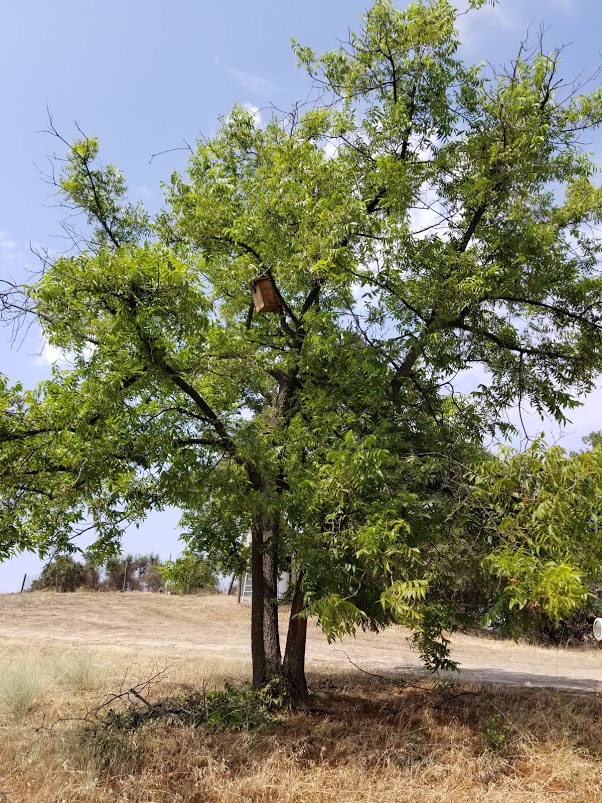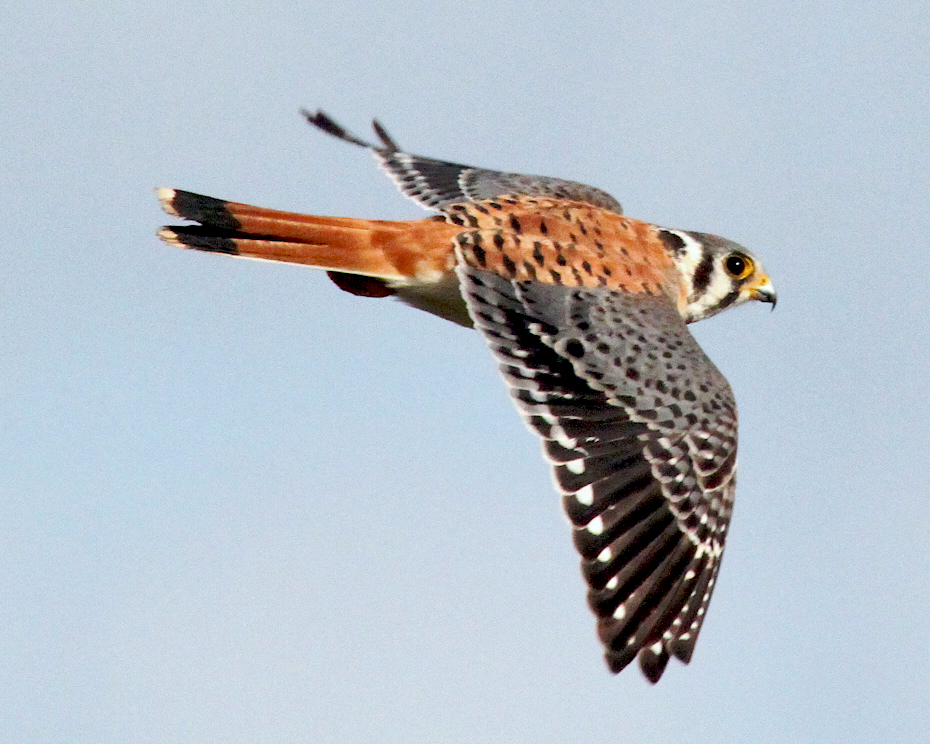"Let's Hope the Birds Move in Soon!"
Margaret Magnus
By Margaret Magnus
THE AMERICAN KESTREL BOX placed in the walnut tree at Meher Mount near Baba's Path. (Photo: Margaret Magnus, August 1, 2018)
When individuals ask, “What are you going to do with Meher Mount?” what they really mean is, “When are you going to build more buildings on the grounds?”
More and more, we all find ourselves explaining that Meher Mount is a preserve of sorts, it’s a sanctuary for wildlife and vegetation. Wilderness is rare in Southern California. Development is not.
It was at Meher Mount that Meher Baba said, “Now, go out and see the view and try to love Baba through nature. This is all due to my love. This whole creation, this nature, all the beauty you see, all came out of me.”
Loving God through nature is a guiding principle for Meher Mount, for the Master Plan, and a key role of this place of pilgrimage dedicated to Meher Baba.
Thomas Fire Destroys Raptor Habitat in the Ojai Valley
Thus, when the Ojai Raptor Center sent out an email after the December 2017 Thomas Fire encouraging landowners to install perches and box homes to support the raptor population in the area, Meher Mount responded.
The center said the fire had destroyed raptor (eagle, hawk, falcon, owl) habitat in the area, and putting up boxes and perches was one way to help the recovery of these birds.
In April 2018, board member and bird watcher Robert Turnage contacted the Ojai Raptor Center to inquire about Barn Owl (Tyto alba) and American Kestrel (Falco sparverius) boxes for Meher Mount.
Meher Mount Installs Owl and Kestrel Boxes
KEVIN McCLOUD from the Ojai Raptor Center installs an American Kestrel (Falco sparvaerius) box in the walnut tree near Baba's Path at Meher Mount. (Photo: Lynn Barnes, July 27, 2018)
To determine the suitability for Meher Mount, the Raptor Center conducted a preliminary assessment. Meher Mount was approved, but due to the demand, there was a waiting list.
Then on July 27, 2018, box installation was scheduled. Board member Jim Whitson and Interim Caretaker Cassandra Bramucci met with Jesse Grantham, a volunteer from the Ojai Raptor Center, and Kevin McCloud, a skilled tree climber who does the box installation.
The group decided on two different locations at Meher Mount for the Barn Owl and the American Kestrel boxes.
“A lot of factors went into each installation: exposure to sunlight, raccoons, squirrels and ants. In addition, we also had to consider the height and the flyway area,” reported Jim Whitson.
McCloud placed the owl box in the Coast Live Oak (Quercus agrifolia) adjacent to the fountain near the Visitor Center. The kestrel box was installed in the walnut tree next to the path that leads to Baba's Tree.
The entire contribution to the Raptor Center (made on behalf of Meher Mount by several people) for the boxes and installation was $400. “It was well worth it!” said Jim. “These guys did a great job and part of the fee includes coming back at a later date to check on how the boxes (nests) are doing.
“Let's hope the birds move in soon!!!”
THE BARN OWL BOX in the Coast Live Oak (Quercus agrifolia) by the pond in the driveway near the Visitor Center. (Photo: Margaret Magnus, July 31, 2018)
A Natural Balance of Nature
Meher Mount was also motivated to install the boxes to create a natural form of rodent control. A simple walk to Baba’s Tree and Avatar’s Point demonstrates the abundance of small rodents (such as gophers, voles, and mice) at Meher Mount. The ground is pock-marked with their holes.
By helping raptors thrive, Meher Mount is helping to keep the predator-prey balance in the ecosystem. The Ojai Raptor Center calls raptors and owls “free, natural and abundant rodent control!” According to the center, a Barn Owl will eat four to six voles or vole-sized rodents a night.
THE DANGER TO WILDLIFE of rat poison in the food chain. (Source: National Park Service)
As a note, the Ojai Raptor Center and other organizations warn against the use of rodenticides – a general term for any rat or rodent poison – to address rodents on a property.
Rodents that are poisoned do not die instantly in the bait boxes that house the poison. They usually die days to weeks after the first ingestion. They wander out of the bait boxes, become lethargic and are easy prey items for predators, thus causing secondary poisoning (often lethal) to wildlife and or domestic animals and pets.
About the American Kestrel
AN AMERICAN KESTREL in flight. (Source: Free Stock Photos)
The American Kestrel (Falco sparverius) is North America’s littlest falcon. They are leaner and less muscular than larger falcons. The length of this falcon is approximately 10.5 inches with a 23-inch wingspan.
According to the National Geographic Society, their loud, ringing killy-killy-killy or klee-klee-klee is distinctive.
They are also one of the more colorful raptors: the male’s slate-blue head and wings contrast with his rusty-red back and tail; the female has the same warm reddish color on her wings, back, and tail. Both sexes have pairs of black vertical slashes on the sides of their pale faces – sometimes called a mustache or a sideburn.
American Kestrels usually snatch their prey from the ground, although some catch quarry in flight. They hunt insects and other small prey in open territory by perching on wires or poles or hovering facing into the wind, flapping and adjusting their long tails to stay in place.
Their habitat ranges from deserts and grasslands to alpine meadows. They can be seen perching on telephone wires along roadsides in open country with short vegetation and few trees.
The American Kestrel was once one of the most common raptors in North America. Lately, however, scientists have noticed that this species’ numbers are beginning to decline in some parts of North America – and no one really knows why. Causes may include loss of habitat, increased predation by other birds of prey, pollution, and competition for nesting sites from species. Conservationists are helping by putting up nesting boxes.
About the Barn Owl
THE BARN OWL (Tyto alba) is the most widely distributed species of owl. (Source: Wikipedia)
The Barn Owl (Tyto alba) is the most widely distributed species of owl and one of the most widespread of all birds. It is also referred to as the common barn owl, monkey-faced owl, ghost owl, and church owl.
It is found almost everywhere in the world except polar and desert regions, Asia north of the Himalayas, most of Indonesia, and some Pacific islands. Despite a worldwide distribution, Barn Owls are declining in parts of their range due to habitat loss.
The Barn Owl is a medium-sized owl with no ear-tufts and a heart-shaped face. The species name "alba" refers to the color white.
Barn Owls don’t hoot the way most owls do; instead, they make a long, harsh scream that lasts about two seconds. This scream is made mostly by the male, who often calls repeatedly from the air. Females give the call infrequently. A softer, more wavering version of this is termed a purring call. Males use it to invite a female to inspect a nest site, and females use it to beg for food from the male. Barn Owls also make a loud, three-to-four second hiss at intruders or predators that disturb the nest.
When agitated, Barn Owls snap their bill mandibles together. As part of a display flight, males sometimes clap their wings together once or twice.
The Barn Owl hunts at night, seldom by day. They catch their prey by flying low over open ground, watching and listening. Sometimes, they hunt by flying down from a perch. The Barn Owl has excellent vision in low light levels, and their hearing is so precise that it can strike prey in total darkness.
Barn Owls feed on voles and various kinds of mice, small rats, shrews, young rabbits, other mammals. They eat very small numbers of birds, lizards, insects, rarely frogs or even fish.
Sources & More Information
Ojai Raptor Center, PO Box 182, Oak View, CA 93022.
All About Birds, "Four Keys to Bird Identification," accessed online July 29, 2018.
American Kestrel
All About Birds, “American Kestrel,” accessed online, July 29, 2018.
Wikipedia, "American kestrel (Falco sparverius)," accessed online, July 29, 2018
National Geographic, “American Kestrel,” accessed online July 29, 2018.
Audubon Guide to North American Birds, “American Kestrel,” accessed online August 23, 2018
he Peregrine Fund, "American Kestrel," accessed online July 29, 2018.
Barn Owl
All About Birds, “Barn Owls,” accessed online July 29, 2018.
Wikipedia, “Barn owl,” accessed online, August 23, 2018.
Audubon Guide to North American Birds, “Barn Owl,” accessed August 23, 2018.
The Owl Pages, “Common Barn Owl – Tyto alba,” accessed August 23, 2018.
Bird Academy, “Learn to Identify Distinct Calls of Owls,” accessed online August 23, 2018.





